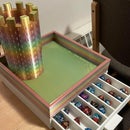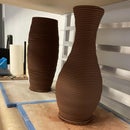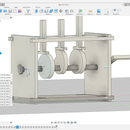Introduction: Week 3 - Lamp Shade
Creating a lamp shade as part of an assignment for MAT238
Step 1: Create Light Model in Rhino
First, I measured the light and imported the light into Rhino with the approximate measurements.
Step 2: Create Draft Lamp Shade
I drew lots of rectangle centered around the light, and then created a mesh of the rectangles. I did this to see if it would approximately fit the lamp and if I could continue with this design. It looked like it fit so I continued on with my design
Step 3: Add Interest to the Lamp Shade
To make my lamp shade more interesting, I rotated each of the rectangle by some angles. My first prototype had a total rotation of 45 degrees across 6 rectangles, and my second prototype had a total rotation of 90 degrees across 6 rectangles. I stuck with the second prototype because it looked more interesting to me
Step 4: Upload to Ultimaker Cura
Upon uploading to Ultimaker Cura, I came across two problems. First, I accidentally made everything twice as big as intended, so I had to recreate the entire design. Second, I realized that there would be too much overhang, so I needed to change my design to account for this.
Step 5: Remaking With Overhang Constraints
I wanted my second draft to work, so I went a little overboard with my lamp shade process. I created 45 rectangles, and had a total rotation of 45 degrees. This meant that every rectangle was rotate by 1 degree, until the 45th rectangle was rotated by 45 degrees. I don't quite understand how to use grasshopper too well in this application, so I manually created the 45 rectangles and manually rotated each rectangle by 1 degree
Step 6: Ultimaker Trial 2
Uploading this new design to Ultimaker Cura, it seems as though most of the overhang problems are solved, and that there was now pretty minimal overhang.




